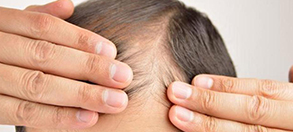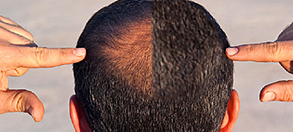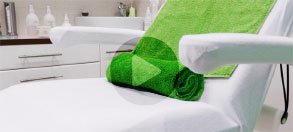One of the first medications people suffering from hair loss turn to is a simple over-the-counter solution called minoxidil. However, you’re likely to recognize it by its most popular brand name: Rogaine.
Minoxidil has been on the market for quite some time, and was first used in the form of a pill under the brand named Loniten to treat hypertension (high blood pressure). Much like with finasteride trials that were testing the drug for treatment of enlarged prostate glands, some of the participants in Loniten trails (all the way back in the 1960’s) reported additional hair growth — but this time, in strange places. In this case, participants reported extra hair on their cheeks, back of the hands, and the forehead.
Of course, this led to some in the medical research community questioning whether or not minoxidil would be an effective hair growth stimulant if used more intentionally. For example, if the medication were say, a cream applied directly to a balding scalp.
We’re proud to be the hair transplant surgeons of choice for pro athletes, actors & celebrities.
Needless to say, the pharmaceutical company (Upjohn, which is now a part of Pfizer) was inundated with volunteers for the topical minoxidil clinical trials. It took a while to get the product to market, but by 1988, Rogaine was available via prescription for topical use in men. In 1991, its use was expanded to women. And in 1996, the FDA made it available over-the-counter.
Since then, countless people across the globe have tried minoxidil to regrow their hair. But is it as effective as finasteride (Propecia)? How is it different?
Let’s dig into the details of minoxidil, how it works, the approved dosage, and known side effects.
Contents
Minoxidil (Rogaine)
While Rogaine is the most recognizable name for this type of hair regrowth medication, minoxidil is the generic name for the drug. In stores where these products are sold, you’re likely to find under multiple brand names unique to each store, like Equate (now privately owned by WalMart), Kirkland (Costco), or Well at Walgreens.
Class of Drug
Minoxidil is classified as an antihypertensive, or a vasodilator, which means its purpose is to dilate (open) blood vessels. Of course, the original intention of minoxidil was to treat high blood pressure, and it’s still widely used for this purpose. However, it’s most commonly associated with hair regrowth because it was a fortunate side effect of the oral medication.
Mechanism of Action
Vasodilators work by opening up blood vessels, essentially relaxing the muscles in arteries and veins so they don’t constrict and become narrow. This process allows blood to flow more freely through the body, which should decrease your blood pressure because your heart doesn’t have to work so hard to pump blood.
As for why minoxidil works for hair loss — the answer isn’t so cut and dry. Because the drug is opening up blood vessels, it’s possible the extra blood flow allows the hair follicles to function more efficiently, and therefore produce more hairs. This could be the reason some people taking oral minoxidil experience hair growth on random parts of the body.
By contrast, finasteride actually reduces production of an enzyme called 5-alpha-reductase, which creates a byproduct called dihydrotestosterone (DHT). Because hair follicles sensitive to DHT tend to shrink over time and stop producing hairs, DHT is believed to be the main cause of male pattern baldness.
Approved Uses
Topical minoxidil is used to treat hair loss caused by male pattern baldness in adults age 18 and older. Oral minoxidil is used primarily to treat high blood pressure.
Dosage
Topical minoxidil typically comes in 2% and 5% doses in both a liquid solution and a foam.
If using the liquid solution, 1ml should be applied to the scalp twice a day (but no more than 2ml per day). If using the foam, apply a half-capful to your scalp twice a day.
How to Use Minoxidil for Hair Loss
Before applying minoxidil, make sure your scalp is dry. If you intend to apply the product after a shower, it may be best to wait for a few minutes. However, you don’t need to wait for your hair to dry — the scalp must be dry, but the hair does not have to be.
If using the liquid solution, fill the eyedropper with 1ml of liquid and apply directly to thinning areas of the scalp, making sure to part hair to expose the scalp as much as possible. Gently rub the solution into your scalp. Make sure the solution has been completely absorbed and your scalp is completely dry before laying down for bed or adding product to your hair for styling.
If using the foam, the instructions are the same, except the dosage. Use a half-capful of foam and gently rub into the scalp. Again, the hair does not have to be dry before applying.
Regardless of whether you’re using the foam or the solution, be sure to thoroughly wash your hands after applying the medication.
If you stop using minoxidil, any effects you’ve noticed will disappear. Much like finasteride, efficacy depends upon consistency, so it will be important to apply the medication twice daily. However, you should not apply minoxidil to damaged skin (i.e. cuts, scrapes, burns — including sunburn).
Doing so could cause too much of the medication to be absorbed and increase the likelihood of more serious side effects. Allowing the scalp to heal should take priority over minoxidil treatments, which can resume once the skin is back to normal.
It may take four to six months before seeing any kind of positive results of minoxidil. If you have any questions about the medication or the effects you’re seeing (or not seeing), speak to your doctor. If you haven’t seen results after a certain period of time (perhaps six months to one year), your doctor may recommend trying finasteride or looking into hair transplants.
Side Effects
Minoxidil is largely well-accepted by most people who use it, meaning that they suffer minor, temporary side effects that disappear on their own without further medical intervention. As with any medication, there are exceptions to this rule.
Some of the more common side effects of minoxidil are burning, stinging or redness at the application sites on the scalp. These effects typically disappear quickly, but if they do not or if they become worse, you should immediately stop using the medication and consult with your doctor.
If you experience any of the following rare side effects, you should discontinue use of the medication and call your doctor immediately:
- Inflammation at the hair roots
- Increased hair loss
- Additional facial hair growth
- Swelling in face or scalp
- Changes in vision, such as blurriness
- Chest pain
- Dizziness
- Fainting
- Heart racing
- Rapid weight gain
- Frequent or persistent headache
Does Rogaine (Minoxidil) Work for Hair Loss?
Minoxidil has been proven to slow down hair loss and regrow some hair. And while it may be the most widely available product for the treatment of hair loss, it’s not effective in all cases.
Since it is over the counter, it is commonly recommended as a first treatment option. Typically, doctors suggest minoxidil as one portion of treatment, or in cases where a patient hasn’t seen results using finasteride. Some have more luck with minoxidil than others, but for the most part, finasteride is seen as the most effective non-surgical option for the majority of men.
Because finasteride isn’t approved for use in women, minoxidil and hair transplants are generally the only options available to them (assuming their hair loss is a result of pattern baldness, and isn’t caused by a medical condition).
Be sure to speak with your doctor before trying minoxidil, as your personal or family medical history may change the likelihood of possible side effects, such as those with known cardiac issues.
Are You Ready to Take the Next Step?
If minoxidil didn’t work for you (or you’re sick of using it) and you’re looking for a more permanent solution for your hair loss, call us for a consultation.
If you’d like to learn more about follicular unit extraction (FUE) and how it differs from the outdated strip procedure, we have a wealth of information on our website. While you’re learning what’s entailed, check out our before and after photos and watch our educational videos — and don’t forget to read reviews from our satisfied clients.
When you’re ready, give us a call. We’d love to discuss your treatment options with you!


